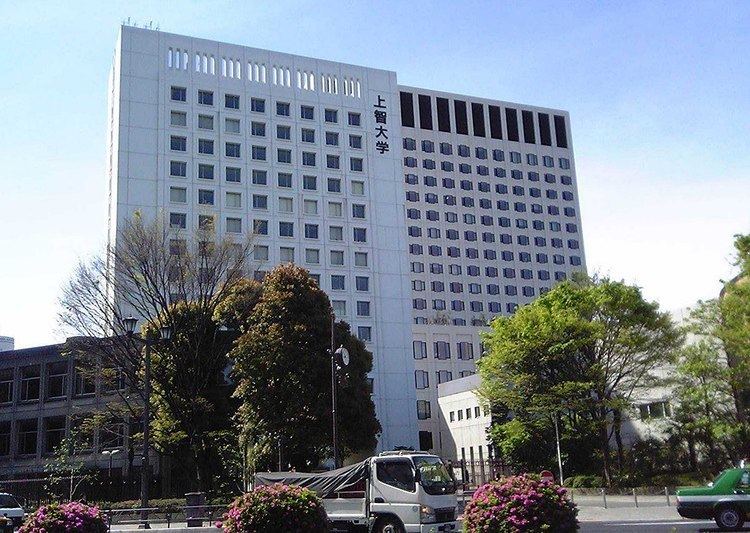Motto Lux Veritatis Acceptance rate 21% (2011) Undergraduate tuition and fees 866,500 JPY (2015) Phone +81 3-3238-3111 | Motto in English Light of Truth Total enrollment 13,435 (1 May 2014) Mascot Sophian-kun | |
 | ||
Type CatholicPrivateResearch University Established 1913; 104 years ago (1913) Chancellor Rev. Fr. Toshiaki Koso, SJ Address Japan, 〒102-0094 東京都千代田区紀尾井町7−1 Founders Joseph Dahlmann, Henri Boucher, James Rockliff Notable alumni Similar Rikkyo University, Tokyo University of Science, Aoyama Gakuin University, Keio University, Hosei University Profiles | ||
Sophia university pr movie full
Sophia University (上智大学, Jōchi Daigaku) is a private Jesuit research university in Japan, with its main campus located near Yotsuya station, in an area of Tokyo's Chiyoda Ward. It is ranked as one of the top private universities in Japan. It takes its name from the Greek Sophia meaning "wisdom". The Japanese name, Jōchi Daigaku, literally means "University of Higher Wisdom".
Contents
- Sophia university pr movie full
- Trail to tokyo ep 4 sophia university
- History
- Campuses
- Popularity and selectivity
- Notable faculty
- Government politics and society
- Academia
- Business
- Media literature
- Others
- References
It has an exchange program with many universities throughout the world, including Yale University, Sogang University and the University of Hong Kong. The university was a men’s university in the past, but at present admits women; the proportion of men to women is now more or less equal. Sophia’s alumni are referred to as "Sophians"; they include the 79th Japanese Prime Minister of Japan, Morihiro Hosokawa, a number of politicians represented in the National Diet of Japan, and professors at various institutions.
Trail to tokyo ep 4 sophia university
History
Sophia University was founded by Jesuits in 1913. It opened with departments of German Literature, Philosophy and Commerce, headed by its founder Hermann Hoffmann (1864–1937) as its first official president.
In 1932, a small group of Sophia students refused to salute the war dead at Yasukuni Shrine in the presence of a Japanese military attache, saying it violated their religious beliefs. The military attache was withdrawn from Sophia as a result of this incident, damaging the university's reputation. The Archbishop of Tokyo intervened in the standoff by permitting Catholic students to salute the war dead, after which many Sophia students, as well as Hermann Hoffmann himself, participated in rites at Yasukuni. The Congregation for the Evangelization of Peoples later issued the Pluries Instanterque in 1936, which encouraged Catholics to attend Shinto shrines as a patriotic gesture; the Vatican re-issued this document after the war in 1951.
Sophia University continued to grow by increasing the numbers of departments, faculty members and students, in addition to advancing its international focus by establishing an exchange program. Many of its students studied at Georgetown University in the United States as early as 1935. Sophia's junior college was established in 1973, followed by the opening of Sophia Community College in 1976. With the founding of the Faculty of Liberal Arts in 2006, Sophia University presently holds 27 departments in its eight faculties. Its current president is Yoshiaki Ishizawa. Toshiaki Koso serves as head of its board of directors. Since 2008, the Global Leadership Program was started for students from four Jesuit universities in East Asia: Ateneo de Manila University in the Philippines, Fu Jen Catholic University in Taiwan, Sogang University in South Korea, and Sophia University in Japan.
Sophia's Research Institutes Division includes 11 research institutes with about 200 researchers.
Campuses
Sophia's main campus, at Yotsuya, is urban, consisting of roughly 25 large, modern buildings in the center of Tokyo, the world's largest city. The majority of Sophia's 10,000 undergraduate students spend nearly all their time here. The faculties of Humanities, Law, Foreign Studies, Economics, Liberal Arts, and Science and Technology have their home here, as do the main library, cafeteria, gymnasium, chapel, bookstore, and offices. In April 2006, the Faculty of Comparative Culture (FCC), which had been located at the smaller Ichigaya campus, moved to the main Yotsuya campus and changed its name to the Faculty of Liberal Arts. Nearly all of Sophia's foreign exchange students study at FLA.
The Tokyo office of the Council on International Educational Exchange (CIEE), the student exchange organization, which oversees roughly half of the international students, is also based on the main Yotsuya Campus. The Shakujii (Tokyo) campus houses the Faculty of Theology. The Hadano campus in Kanagawa Prefecture is home to the Sophia Junior College, as well as a number of seminar halls and athletics complexes.
Popularity and selectivity
Sophia University is one of the most selective universities among 730 private universities in Japan.
